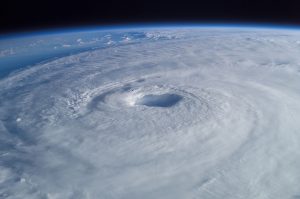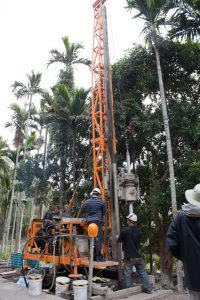9 January 2018
Study suggests heavy rains from tropical cyclones distort the ground below
Posted by Lauren Lipuma

A view of Hurricane Isabel seen from the International Space Station in 2003. New research finds torrential rainfall during a tropical cyclone could be responsible for reshaping the shallow layer of Earth’s crust in the days following the storm.
Credit: Mike Trenchard, Earth Sciences & Image Analysis Laboratory, NASA Johnson Space Center.
By Olivia Trani
Torrential rainfall during a tropical cyclone could be responsible for reshaping the shallow layer of Earth’s crust in the days following the storm, according to new research.
Earth’s surface is constantly shifting, expanding and compressing in response to atmospheric and hydrologic forces from aboveground.
Scientists have previously suggested that tropical cyclones could cause contortion below Earth’s surface, called ground deformation, because researchers have documented both dilatation, or expansion, and compression of Earth’s crust after severe storms. Previous studies have suggested that dilatation from cyclones could trigger slow earthquakes that could cause compression.
The new study in Geophysical Research Letters, a journal of the American Geophysical Union, finds that compression of Earth’s crust is correlated with heavy rainfall from hurricanes and typhoons, known collectively as tropical cyclones. The added weight of all that water likely causes the ground underneath the storm to deform, according to the study’s authors.
“All those kinds of elements can alter the shape of the solid Earth,” said Maxime Mouyen, a geophysicist at the University of Rennes in Rennes, France and lead author of the new study.

Scientists in Taiwan prepare to install several borehole strainmeters into the ground to monitor ground deformation after tropical cyclones pass overhead.
Credit: Maxime Mouyen.
Measuring ground deformation
In the new study, researchers examined tropical cyclones and ground deformation in Taiwan, a region subject to both frequent tropical cyclone and earthquake activity. The island is situated between the Eurasian and Philippine Sea plates, two tectonic plates that are shoved closer together each year, resulting in increased seismicity along plate boundaries.
To see if there was a connection between tropical cyclone rainfall and ground deformation, the scientists first analyzed tropical cyclone rainwater data recorded by rainfall gauges in eastern Taiwan from 2004 to 2013. They used that data to estimate how much strain, or changes to size and shape, the rainfall from tropical storms could create in Earth’s crust.
The researchers then compared their strain estimates to actual strain measurements from Taiwan. These measurements came from ground deformation data collected during the same 10-year period by seven borehole strainmeters — devices that are drilled hundreds of meters into the Earth to monitor ground deformation events. Over the course of a decade, strainmeters located near the rainfall gauges recorded 72 cases of deformation occurring after 31 tropical cyclones.

Borehole strainmeters are drilled hundreds of meters into the Earth to monitor ground deformation events.
Credit: Maxime Mouyen.
The research team found the strainmeters could detect ground compression a few days after tropical cyclones passed over a certain area. The observational strainmeter measurements from Taiwan closely matched the amount of strain the researchers projected, suggesting that tropical cyclones were the primary drivers of these ground deformation cases, according to the authors.
The study’s authors conclude that the pressure from rainwater flowing into valleys likely caused the ground underneath to deform under the weight of all that water.
Triggering earthquakes
The results of the new study call into question whether tropical cyclones can trigger earthquakes. An earlier study published in the journal Nature suggested that dilatation of the Earth’s crust by cyclones triggered slow earthquakes that caused compression of the crust. But the new study suggests that heavy rainfall, rather than slow earthquakes, causes compression.
The amount of ground deformation detected by the strainmeters in the new study is similar in strength to local seismic events, sometimes as strong as magnitude 5 earthquakes. However, they take place over a longer span of time. Strain associated with earthquakes occurs within seconds to minutes, while strain induced by tropical cyclones happens over several hours to days.
The researchers say it is possible that this two-punch effect can lead to earthquakes, but this hypothesis needs to be proven with seismic data.
“The question is whether or not we can reach the amount of stress which is big enough to then trigger seismic activity,” Mouyen said. “There is no reason to say no it can’t do that, but so far there is no pure observation that [tropical cyclone] occurrence is correlated with an increase in seismic activity.”
— Olivia Trani is a public information intern at AGU.










 GeoSpace is a blog on Earth and space science, managed by AGU’s Public Information staff. The blog features posts by AGU writers and guest contributors on all sorts of relevant science topics, but with a focus on new research and geo and space sciences-related stories that are currently in the news.
GeoSpace is a blog on Earth and space science, managed by AGU’s Public Information staff. The blog features posts by AGU writers and guest contributors on all sorts of relevant science topics, but with a focus on new research and geo and space sciences-related stories that are currently in the news.